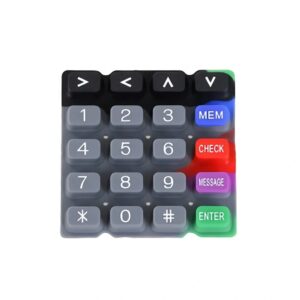Hey,guys,do you want to know why the silicone rubber keypad is better than the touchscreens.I believe you must have question that because todys technology is improve,and most of us are using the smartphone with touchscreens.Why the keypad is bettber than that one.I think you will become more clear from today’s learning.
Silicone keypads outshine touchscreens in various aspects, making them the superior choice for applications in medical devices, point-of-sale systems, and offices. Despite the popularity of touchscreens in smartphones and tablets, silicone keypads offer distinct advantages in terms of versatility, usage, functionality, and durability. Here are five compelling reasons to opt for silicone keypads over touchscreen alternatives.
- Precision of Silicone Keypads
Silicone keypads excel in accuracy, surpassing touchscreen alternatives. Their tactile feedback minimizes errors, crucial in applications like medical devices. With distinct button boundaries, users efficiently locate keys, ensuring precision. The durable nature of silicone maintains accuracy over time, offering a reliable input solution.
- Silicone Keypads Exhibit Enhanced Responsiveness
Silicone keypads offer superior operability compared to touch screens, enabling usage even when operators wear gloves, such as latex gloves in medical settings or winter gloves on construction sites. The physical buttons of silicone keypads facilitate ease of use, eliminating the need to remove gloves for command inputs—a significant convenience across various industries.
- Silicone Keypads Maintain Clean Surfaces
The inherent drawback of touchscreens lies in their susceptibility to smudges and fingerprints, compromising visibility and usability. The need for frequent screen cleaning disrupts productivity and increases the likelihood of selecting incorrect options. Silicone keypads, on the other hand, eliminate this issue as smudges on keys do not affect functionality.
- Silicone keyboard with better click response
 The pronounced and audible click of silicone keypads provides a tactile confirmation of button activation, offering a distinct advantage over touchscreens. This physical sensation ensures users that their input is registered, providing a reliable and satisfying interaction. While touchscreen devices may incorporate simulated click sounds, they lack the tangible feedback associated with the physical depression of silicone buttons, reinforcing the accuracy and assurance of user input.
The pronounced and audible click of silicone keypads provides a tactile confirmation of button activation, offering a distinct advantage over touchscreens. This physical sensation ensures users that their input is registered, providing a reliable and satisfying interaction. While touchscreen devices may incorporate simulated click sounds, they lack the tangible feedback associated with the physical depression of silicone buttons, reinforcing the accuracy and assurance of user input.
- Silicone Keypads Cost-effective
Silicone keypads present a more cost-effective manufacturing solution compared to touchscreens. The initial production costs are lower, and ongoing maintenance expenses are reduced due to their durability. Touchscreens, being more intricate and expensive to repair, often requiring specialized expertise, make silicone keypads a pragmatic choice for a long-lasting and resilient interface solution.
![]() In today’s study, I believe you have learned why silicone keyboards are better than screen touch. It’s all about haptic feedback, my friends. There’s something strangely satisfying about actually pressing the button and knowing your command has been registered. It’s like getting a high-five from your device every time you type.
In today’s study, I believe you have learned why silicone keyboards are better than screen touch. It’s all about haptic feedback, my friends. There’s something strangely satisfying about actually pressing the button and knowing your command has been registered. It’s like getting a high-five from your device every time you type.
But hey, let’s not underestimate the screen touch capabilities just yet. It has its own charm, especially when it comes to swiping and scrolling. It’s like a smooth, seamless waltz on screen, and there’s definitely a certain elegance to it.
All in all, both silicone keyboard and screen touch have their own uniqueness and charm. It’s like comparing apples and oranges – both are delicious in their own way. So whether you’re a Team Silicone Keyboard or a Team Screen Touch, let’s embrace these quirks and keep the tech world a vibrant and fun place.